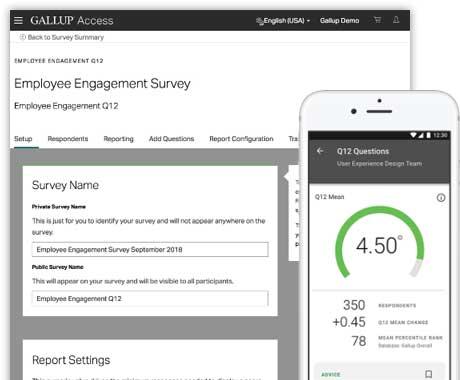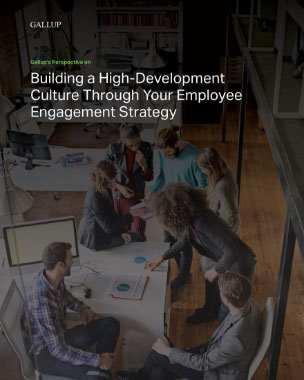Story Highlights
- Next-generation agile structures can endanger engagement
- Someone must be accountable for team and company engagement
Agile organizational models are designed to speed products to market and internal projects to completion by removing unnecessary bureaucracy and decision-making hierarchies. Lately, more and more leaders have been experimenting with next-gen models -- e.g., the Spotify or McKinsey structures -- centered on self-organized, cross-functional, end-to-end, manager-less teams.
Such methods promise improved adaptability to changing priorities, quicker time-to-market and better product/market fit, because experts across the value chain can directly collaborate and have wide-ranging decision-making power, based on direct customer feedback.
But it's not organizational structures that create great workplaces and great business outcomes. Structures don't help people perform to their fullest. Frameworks don't make people love their jobs. Managers do, at least in traditionally organized companies.
In fact, Gallup finds that the local manager is responsible for at least 70% of the variance in team engagement because they have a tremendous influence on employees' everyday experiences.
But next-gen agile teams don't have a local manager. So, who's looking out for their engagement?
The Most Vulnerable Elements of Engagement in Self-Managed Teams
Gallup's extensive workplace research uncovered 12 basic needs that must be fulfilled for employees to fully commit to their work and deliver great performance.
Members of self-organized teams have the same engagement needs as anyone else, but they don't have a traditional team lead taking accountability for engagement.
Instead, they have several quasi-managers splitting responsibilities: a functional manager focused on role fit and development, a product owner focused on team outcomes, and an agile coach focused on workflows.
In this setting, with high levels of autonomy and without clear accountability, engagement can be a challenge -- and some elements prove to be especially vulnerable.
"At work, I have the opportunity to do what I do best every day."
To fulfill this engagement need, people must be in the right role and feel empowered to work in their own way. In a traditional structure, managers are responsible for matching talent to role -- helping people discover their strengths, positioning people to use them, and always seeking the balance between fit and stretch.
Agile structures let team members find their own balance, with wide-ranging autonomy inside their area of responsibility. They get support from functional managers and agile coaches, but functional managers can be too far from the action and agile coaches usually focus on structures and workflows, not leveraging strengths. Given that most people have little self-awareness of their unique talents and don't know how to capitalize on them, getting the best out of people in a self-organized team can't be assumed.
"In the last seven days, I have received recognition or praise for doing good work."
To be engaged, workers need to know they're valuable to their team. Responsibility for a clearly defined link in the value chain is not enough. Individuals need to know that their team members see and appreciate their good work. While an agile organization can certainly fulfill the rational need for clear expectations (set by the product owner) and provide continuous feedback from customers, that doesn't automatically fulfill the emotional need to be appreciated for work done well.
"There is someone at work who encourages my development."
Having opportunities to develop perhaps isn't as important to engagement as feeling encouraged to develop, and for that people need other people. Two-thirds of employees who report having someone at work who encourages their development are classified as "engaged."
While development is the responsibility of the functional manager, this leader rarely is close enough to employees' daily experiences to legitimately coach or mentor individual development. And though structured learning is an important aspect of development, individual development requires the attention of someone who really knows the worker and their strengths and opportunities.
How to Sustain Engagement in an Agile Workplace
Moving from a traditional structure to a self-organized team changes every part of the work experience. It can provide greater autonomy and empowerment, more accountability, and higher levels of collaboration in a team of equals. It can create great employee engagement, driving great outcomes.
Or it can go horribly wrong.
A "tragedy of the commons" effect can happen -- if everyone is responsible for engagement, no one will feel accountable for it.
To keep engagement levels high, leaders need to implement these three core strategies in agile organizations:
-
Distribute responsibility and select for people management talent. In a traditionally structured company, managers should be responsible for driving engagement. It's the ideal setup -- managers largely control the team environment and are personally responsible for team performance.
In the absence of a traditional manager, the responsibility to create an engaging workplace needs to be distributed across the organization, from the value-creating and functional teams up to the larger "tribe" structure.Leaders need to develop and implement engagement-focused activities and continuously communicate, promote and model the importance of engagement. The three distinct "agile" roles -- functional manager, product owner and agile coach -- need to be aligned, empowered, capable and accountable to the needs of the workforce.
They also need to be carefully selected for their management talent: Functional managers need to be great coaches, able to develop people they don't necessarily work with daily. Product owners must be able to set clear expectations and hold team members accountable. And agile coaches must have the talent to create a strengths-focused environment with a high degree of psychological safety so people will voice their opinions and coordinate their work with their talents.
-
Get a detailed understanding of the situation. Given the different influences on people's workplace experiences in an agile organization and the multiple responsibilities across the various teams, organizations should dig deeper when analyzing engagement. Look at the data for both the value-creating team and the functional team, as well as the overall "tribe" structure. This provides leaders and team members with a more complete picture of engagement across the organization and highlights barriers to engagement that might otherwise be hidden.
-
Leverage strengths to foster empowerment and collaboration. To feel enabled, people must feel confident in their abilities. To perform with excellence, they must understand their individual talents. A strengths-based approach to development empowers people by illuminating their natural tendencies and how to leverage them to drive performance. That's especially important for agile workers, who are expressly encouraged to design their own workflows and approaches to get the job done.
In addition, both collaboration and inclusion are the keys to success in an agile structure. Strength-based workplaces have proven to be significantly more collaborative and inclusive because team members understand the unique talents they each bring, and a strengths-based approach offers a common, positive language for diversity.
Manager or no, employees need to engage.
The impact of a manager, good or bad, is hard to overstate. So are the effects of engagement: higher productivity, higher profitability, greater safety, less turnover -- the list is long.
When leaders experiment with different models of agility, they need to understand that no structure can change or automatically fulfill their workforce's engagement needs. There are many ways to oversee and create engagement, and some will suit a culture better than others. But no matter what organizational structure a company uses, every employee -- especially those belonging to manager-less teams -- must get what they need to engage and perform to their full potential.
So, if a company commits to a manager-less structure, it needs to select and equip someone to oversee engagement. Perhaps many people are more effective than just one, depending on the organization. But the "engagement manager" has to be as accountable for engagement as functional managers are for development, or product owners are for outcomes, or agile coaches are for workflows.
Because if everyone is equally responsible for engagement, no one will feel accountable for it. And if no one is responsible for engagement, the structure won't matter much to workers.
Push employee engagement through the roof:
- Make engagement central to your business strategy by partnering with Gallup.
- Want a high-development culture? Learn how your engagement strategy can get you there.
- Get the No. 1 employee engagement survey and all the strategic advice that goes with it.




